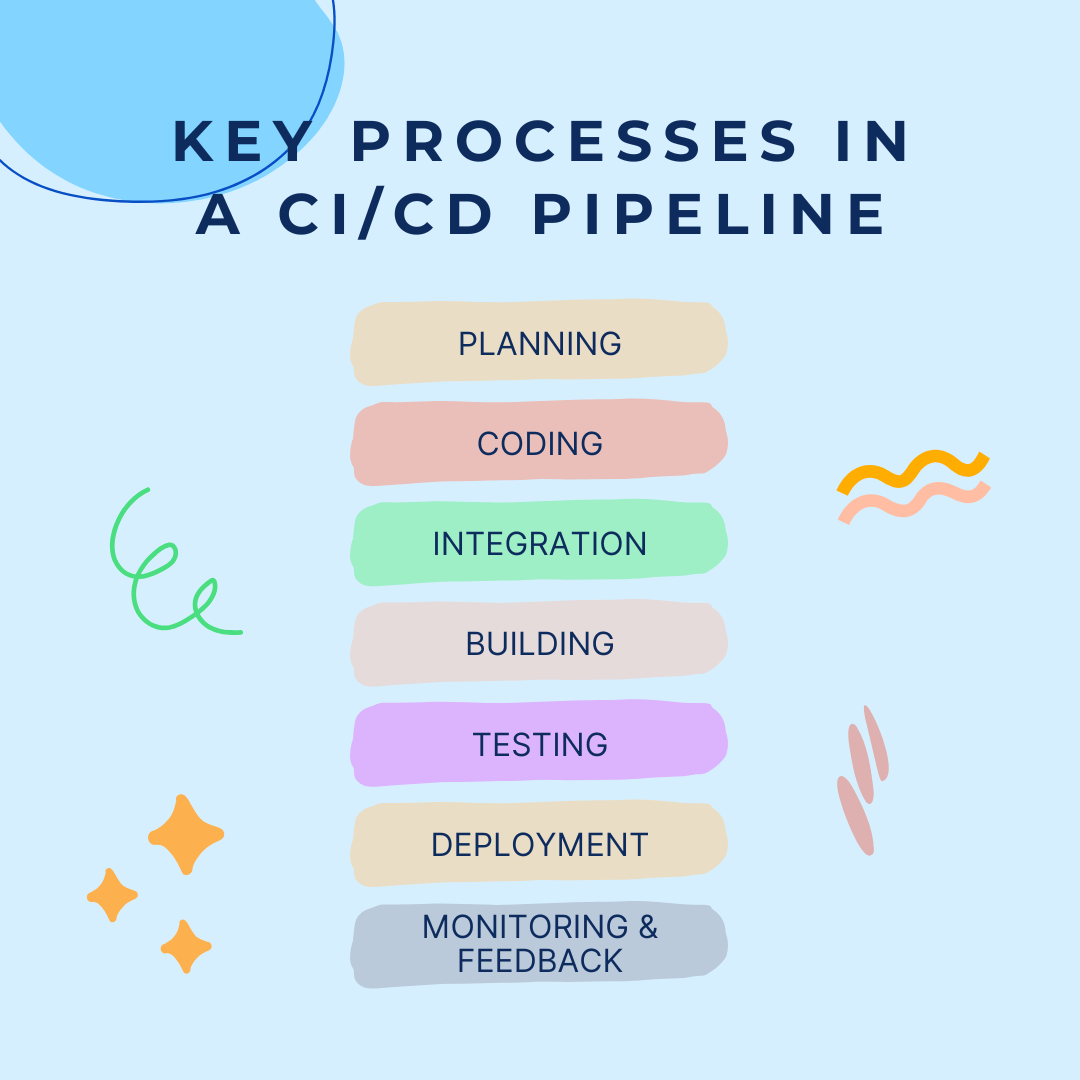Introduction
Delivering software efficiently is often slowed down by manual processes, leading to delayed releases and frequent errors. As development teams grow, the need for speed clashes with maintaining high-quality standards, creating bottlenecks.
A CI/CD pipeline offers a streamlined approach to automate integration, testing, and deployment, ensuring faster delivery while minimizing errors. This guide explains how a CI/CD pipeline works, its benefits, and the tools that can help teams release better software, faster.
What is CI/CD?
CI/CD stands for Continuous Integration (CI) and Continuous Delivery (CD), two critical practices in modern software development.
Continuous Integration (CI) is the process of regularly merging code changes into a shared repository, often multiple times a day. Developers automate the testing and integration processes to catch errors early, ensuring the new code doesn't break the existing system.
Continuous Delivery (CD) builds on Continuous Integration by automating the process of deploying integrated code to production environments. After passing automated tests, the code is prepared for deployment, which can either be manual or fully automated (known as Continuous Deployment).
In the DevOps landscape, CI/CD pipelines help eliminate silos between development, testing, and operations teams by fostering collaboration and speeding up software releases. This approach ensures faster feedback loops, quicker bug fixes, and consistent updates to applications.
CI/CD empowers teams to focus on innovation while minimizing risks and downtime, aligning well with agile and DevOps principles.
Key Processes in a CI/CD Pipeline
A CI/CD pipeline consists of several key processes that streamline software development and deployment:
- Planning: Setting project goals, feature definitions, and timelines.
- Coding: Writing and managing source code.
- Integration: Involves combining code changes into a central repository with the help of automated tools.
- Building: Converting code into a deployable package.
- Testing: Automated tests to ensure code quality.
- Deployment: Automatically releasing code to production or staging environments.
- Monitoring & Feedback: Gathering real-time performance metrics for improvements.

Types of CI/CD Pipelines
There are several types of CI/CD pipelines, each designed to meet different development needs:
- Single vs. Multi-Environment Pipelines: Single-environment pipelines deploy to one environment, while multi-environment pipelines move through stages like development, testing, and production.
- Concurrent vs. Sequential Processes: Pipelines can run tasks in parallel (concurrent) or one after the other (sequential), depending on the project’s complexity.
- Canary Deployments: This involves rolling out updates to a small user base first, minimizing risk while gathering feedback before full deployment.
Why CI/CD is Essential for Modern Development
CI/CD pipelines are crucial for speeding up software delivery without sacrificing quality. By automating code integration, testing, and deployment, teams can release updates hundreds of times per day, improving software velocity.
This approach minimizes manual errors, ensuring more consistent and reliable releases. CI/CD also enhances user experience by allowing rapid bug fixes and feature rollouts. Additionally, it enables seamless rollbacks in case of issues, making systems more resilient.
Security integration within the pipeline further strengthens the development process, helping teams to meet compliance and security standards effectively.
Common CI/CD Pipeline Tools
Several tools power a CI/CD pipeline, each handling different stages of development:
- Source Code Management: GitHub, GitLab, and Bitbucket are popular for managing code repositories.
- CI Servers: Jenkins, CircleCI, and Travis CI automate integration and testing processes.
- Build & Test Automation: Docker and Selenium are used to automate builds and tests.
- Deployment Automation: Kubernetes and Terraform manage deployments and infrastructure.
- Monitoring & Feedback: Tools like Prometheus and Grafana track performance metrics and enable continuous feedback.
Security in CI/CD: Introduction to DevSecOps
In modern software development, integrating security into every stage of the CI/CD pipeline is critical. DevSecOps ensures that security is integrated as a fundamental aspect of the development process rather than being addressed later. Embedding security measures early and throughout the pipeline allows teams to detect vulnerabilities before they escalate into expensive problems.
Integrating Security in Every Stage: DevSecOps aims to weave security into each phase of the CI/CD pipeline—planning, coding, building, testing, deploying, and monitoring. This proactive approach allows for continuous security checks, reducing risks without slowing down the release cycle.
Tools for Enhancing Security: Several tools facilitate security in CI/CD pipelines. Static Application Security Testing (SAST) tools analyze code for vulnerabilities before it’s compiled. Dynamic Application Security Testing (DAST) tools identify security weaknesses in applications while they are actively running. Tools like OWASP ZAP and Snyk help automate vulnerability scanning, while security plugins for CI/CD platforms like Jenkins or GitLab further streamline the process.
Strategies for DevSecOps Success: To succeed with DevSecOps, teams must adopt a culture of collaboration, where developers, security professionals, and operations teams work together. Regularly updating security tools, educating team members on secure coding practices, and enforcing access controls are key strategies for maintaining security across the pipeline.
Cloud vs. On-Premise CI/CD Pipelines
When choosing between cloud-based and on-premise CI/CD pipelines, several factors come into play, including cost, flexibility, and control.
Cloud-Native CI/CD Pipelines: Cloud-based CI/CD solutions, such as AWS CodePipeline and Azure DevOps, offer scalable, flexible, and cost-effective options. They support rapid deployment and integration with other cloud services, enabling automatic scaling based on demand. These solutions are ideal for teams that need high availability, global access, and integration with various cloud-native tools. However, they may involve recurring costs and potential data privacy concerns.
On-Premise CI/CD Solutions: On-premise tools like GitLab and Jenkins provide more control over the infrastructure and data. They are suited for organizations with stringent security requirements or those that prefer to manage their hardware and software environments. While they offer customization and potentially lower long-term costs, they require significant upfront investment and ongoing maintenance.
Pros and Cons: Cloud-based solutions offer ease of use, scalability, and integration with other cloud services, but may present challenges with data control and recurring costs. On-premise solutions provide more control and can be more cost-effective in the long run, but they require substantial infrastructure investment and maintenance.
Best Practices for Optimizing Your CI/CD Pipeline
To maximize the efficiency and effectiveness of your CI/CD pipeline, adhering to best practices is crucial. Here are some key strategies:
1. Automate Everything: Automation is the cornerstone of a successful CI/CD pipeline. From code integration to deployment, automating each stage reduces human error and speeds up the process. Use tools like Maven or Gradle for build automation, Selenium for test automation, and Ansible or Docker for deployment automation to streamline workflows and maintain consistency.
2. Continuous Feedback and Improvement: Implement continuous feedback mechanisms to monitor and refine the pipeline. Utilize monitoring tools and dashboards to track performance, detect issues early, and gather insights. Regularly review feedback from team members and stakeholders to make iterative improvements to the pipeline.
3. Embrace Version Control: Maintain all pipeline configurations and scripts in version control systems like Git. This practice not only ensures that changes are tracked and reversible but also enables collaboration and versioning of your CI/CD processes.
4. Implement Robust Testing: Ensure comprehensive testing at every stage of the pipeline. Implement unit tests, integration tests, and end-to-end tests to methodically identify and resolve issues early in the development process. Use parallel testing and test optimization techniques to speed up the testing phase without sacrificing quality.
5. Prioritize Security: Make security a priority by integrating best practices at every stage of the CI/CD pipeline. Implement static code analysis, dynamic application security testing, and vulnerability scanning to identify and mitigate security risks early. Secure your pipeline infrastructure and access controls to prevent unauthorized changes.
6. Leverage Case Studies: Learn from organizations that have successfully implemented CI/CD pipelines. Analyzing their approaches and results can provide valuable insights and inspiration for optimizing your own pipeline.
Key Takeaways
- CI/CD Pipelines Enhance Efficiency: Streamline software delivery by automating integration, testing, and deployment processes.
- Security Integration is Crucial: Implement DevSecOps practices to address security risks at every stage of the pipeline.
- Cloud vs. On-Premise Choices: Cloud solutions provide scalability and convenience, while on-premise systems offer enhanced control and customization.
- Automation is Key: Streamline build, test, and deployment processes with automation to minimize errors and speed up delivery.
- Continuous Feedback Drives Improvement: Regularly gather feedback and use monitoring tools to refine and optimize the pipeline.
Conclusion
CI/CD pipelines play a vital role in delivering software quickly and efficiently. Automating integration, testing, and deployment boosts agility while minimizing errors. Incorporating security through DevSecOps ensures applications are protected against potential vulnerabilities.
Choosing between cloud-based and on-premise solutions depends on your need for flexibility versus control. Cloud solutions deliver scalability, whereas on-premise options offer greater customization.
Optimizing your pipeline involves automating all stages, collecting continuous feedback, and following best practices. This approach ensures faster, more reliable software releases and better overall quality.

